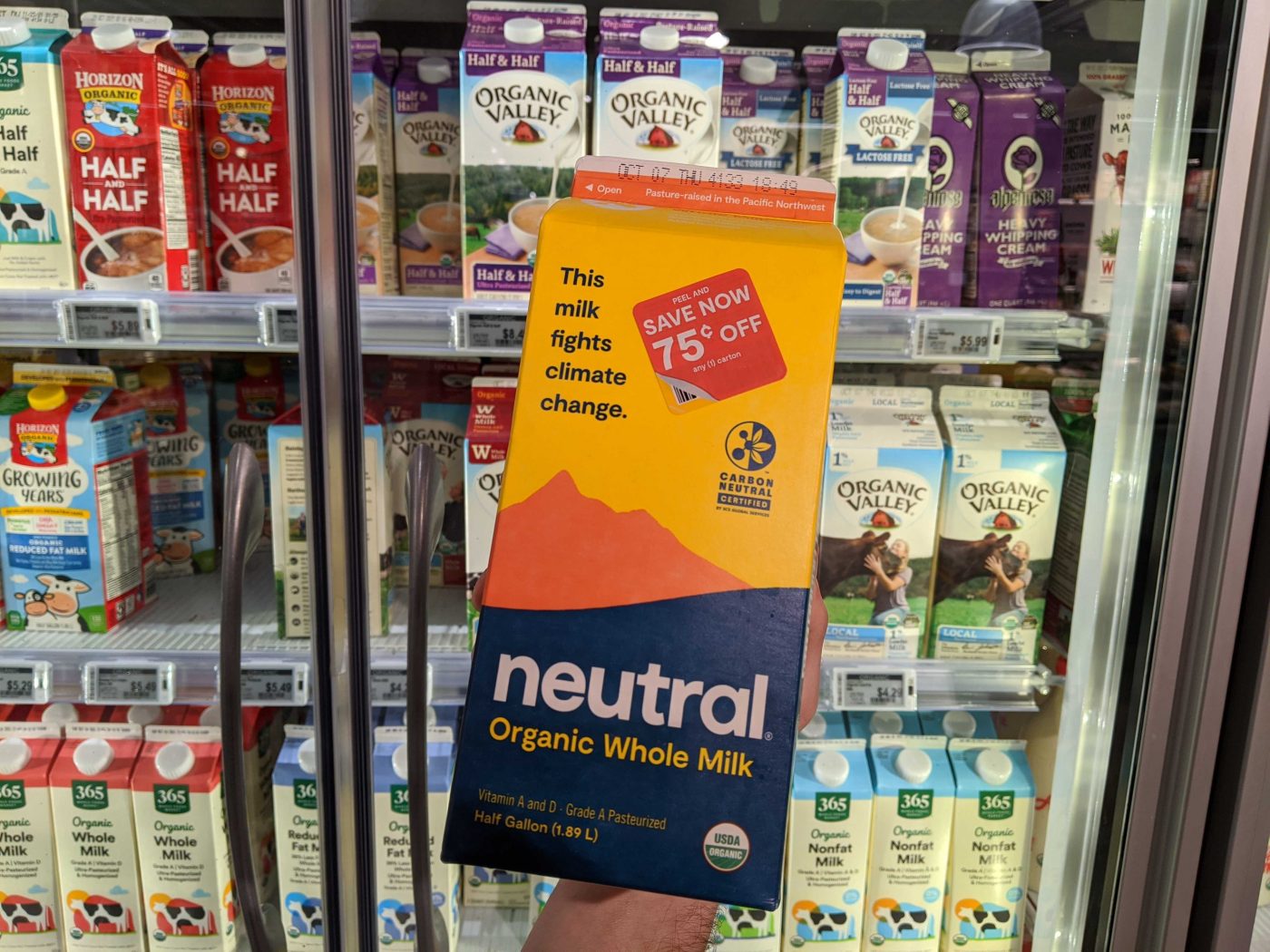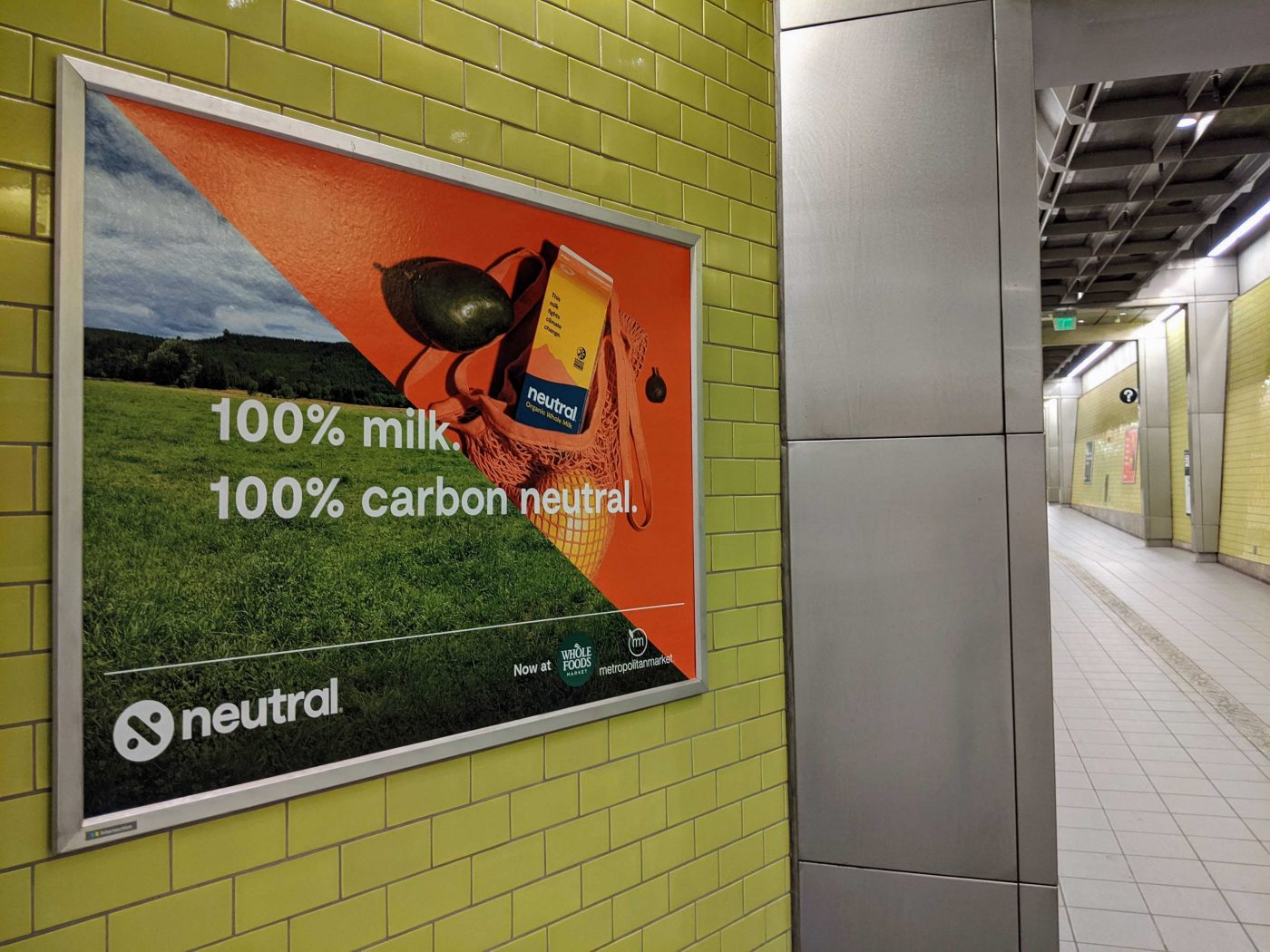The ad blitz was impossible to miss walking into the light rail station in Seattle’s bustling Capitol Hill neighborhood, where dozens of red-orange signs were plastered along the walls. “Seattle, carbon-neutral milk is here,” a billboard-sized advertisement declared, showing two milk cartons perched on a skateboard. One man paused to consider one of the ads for a solid 10 seconds before walking up a staircase that, if you looked at it straight on, spelled out the message “This milk fights climate change.”
Those are big promises from Neutral, the Portland startup behind the product. After all, the dairy industry isn’t exactly known for being climate-friendly: Livestock account for about 14.5 percent of greenhouse gas emissions, two-thirds of which come from cows raised for meat and milk products. Cows burp a lot of methane, a powerful greenhouse gas that the U.N. Intergovernmental Panel on Climate Change recently singled out for its big contributions to global warming, second to carbon dioxide.
So is it possible that Neutral’s milk “fights climate change”? It depends how you interpret it.
“I think there’s an increasing awareness that agriculture has a very big footprint, and most of that footprint is in animal proteins, and a big piece of that is a dairy,” said Marcus Lovell Smith, Neutral’s CEO. Formerly Google Fiber’s chief technology officer and a recent entrepreneur in residence at Harvard, Smith is uniquely positioned for his new role, having run an actual dairy farm in addition to a handful of startups.
Neutral works to reduce emissions on dairy farms by changing the way feed is grown and the way cows eat, by managing manure and fertilizer differently, and through practices to improve soil, like reducing tillage and planting cover crops. That doesn’t cover all of the emissions from its dairy projects, so the company relies on carbon offsets to cancel out the rest, hence “neutral.”

The company’s milk got early support from bougie grocery stores in the Pacific Northwest, showing up in New Seasons in Portland and Metropolitan Market in Seattle. In August, Neutral’s milk got a bigger platform, landing in more than 170 Whole Foods stores across the West, including a handful in the Midwest and South. Later this year, it’s expected to roll out to the rest of the chain’s stores around the country.
“The initial target audience, not surprisingly, is a strong overlap with your Whole Foods consumer,” Smith said. “But in order to get to scale, we need to have this milk available to all Americans.”
The milk aisle has gone through some changes in the last few years, with more and more fridge space devoted to non-dairy alternatives, which tend to have a lighter ecological footprint. Consumption of dairy milk has fallen 40 percent per person in America since 1975, for a variety of reasons. Soy milk started taking off in the 1990s, and much more recently, oat milk has soared in popularity in fancy coffee shops. But most Americans still prefer whole or 2 percent milk, with just 12 percent keeping cartons of almond, oat, or other non-dairy milk around, according to a Morning Consult poll from earlier this year. The poll shows that the environment is a concern for about half of alternative milk drinkers, with taste topping all other considerations.
The idea behind Neutral is to convince environmentally-conscious dairy lovers that they don’t have to give up their favorite beverage for the climate — they just need to pay extra. When I stopped by a local Whole Foods in Seattle last week, there were only two cartons left, even though organic whole milk was among the more expensive milks on display, at $5.49 for a half-gallon (the attached $0.75 coupons might have helped).
Other food companies have started to go the carbon-neutral route. Maple Leaf Foods, a Canadian company that produces meat and meat alternatives, claimed to be the world’s first carbon-neutral food company in 2019. The nonprofit company Climate Neutral, which assesses companies’ carbon-neutral promises, has certified more than 40 food and beverage companies.

As for Neutral’s slogan that its milk fights climate change, “It could be true or it could be really disingenuous,” said Isaac Emery, the founder and principal consultant at Informed Sustainability Consulting in Seattle. Neutral’s promise relies on “avoided emissions” — meaning that by swapping a high-emissions milk for a low-emissions one, presto, you’ve avoided some emissions. It’s not actively drawing carbon down from the sky, he pointed out.
“It’s a question of how you look at it — do you look at it as in ‘buying this product benefits the climate,’ or do you look at it in terms of ‘buying this product instead of the other one is a net benefit’?” Emery said.
Critics note that the climate crisis isn’t really a problem we can shop our way out of by buying “green” products.
In general, Emery said, it seems like Neutral is taking the right approach with lowering emissions on dairy operations. “They’re talking about reducing climate impacts through pretty reliable and important ways,” he said. The company says it measures its carbon footprint “obsessively” and has enlisted the help of Greg Thoma, a professor at the University of Arkansas who studies how to improve the sustainability of food products.
On the other hand, Emery said, you can look at what Neutral is doing — managing the land, animals, and manure more responsibly — as sort of the “bare minimum” of what dairy companies should be doing. “We have not been good stewards of the land for the last 50-plus years,” he said. “Basically, we’re undoing damage.”
And offsetting emissions requires some careful accounting. You can plant forests, but sometimes they go up in flames, releasing all that carbon back to the sky. Emery said that Neutral appears to be “doing their due diligence” by getting third-party verified, accredited offsets “through some of the really robust marketplaces out there.” (Neutral’s offsets come from investing in improvements on other dairy farms.)
Jude Capper, an animal scientist and livestock sustainability consultant, said in an email that the company’s choice to buy carbon offsets was “laudable,” but not “quite the same as being actually carbon neutral at the farm level.” She envisions a future where the dairy industry as a whole “can be carbon neutral without having to rely on offsets,” by improving cow nutrition, genetics, management, and efficiency.
For now, at least, as Emery says, “The cows are still there — they’re still burpin’ and poopin’.” He adds that beyond methane emissions, cow’s milk has a large “land footprint.” The space required to grow cattle feed, for instance, could otherwise be used for growing carbon-capturing prairies.
“Is Neutral milk lower carbon, fundamentally, than other dairy competitors? Yeah, it probably is,” he said. “If you’re going to drink dairy milk, that’s probably the responsible carbon way to do it. But if all you’re drinking is some kind of milk, then it’s probably more climate-friendly to get your store-brand oat milk or soy milk.”



